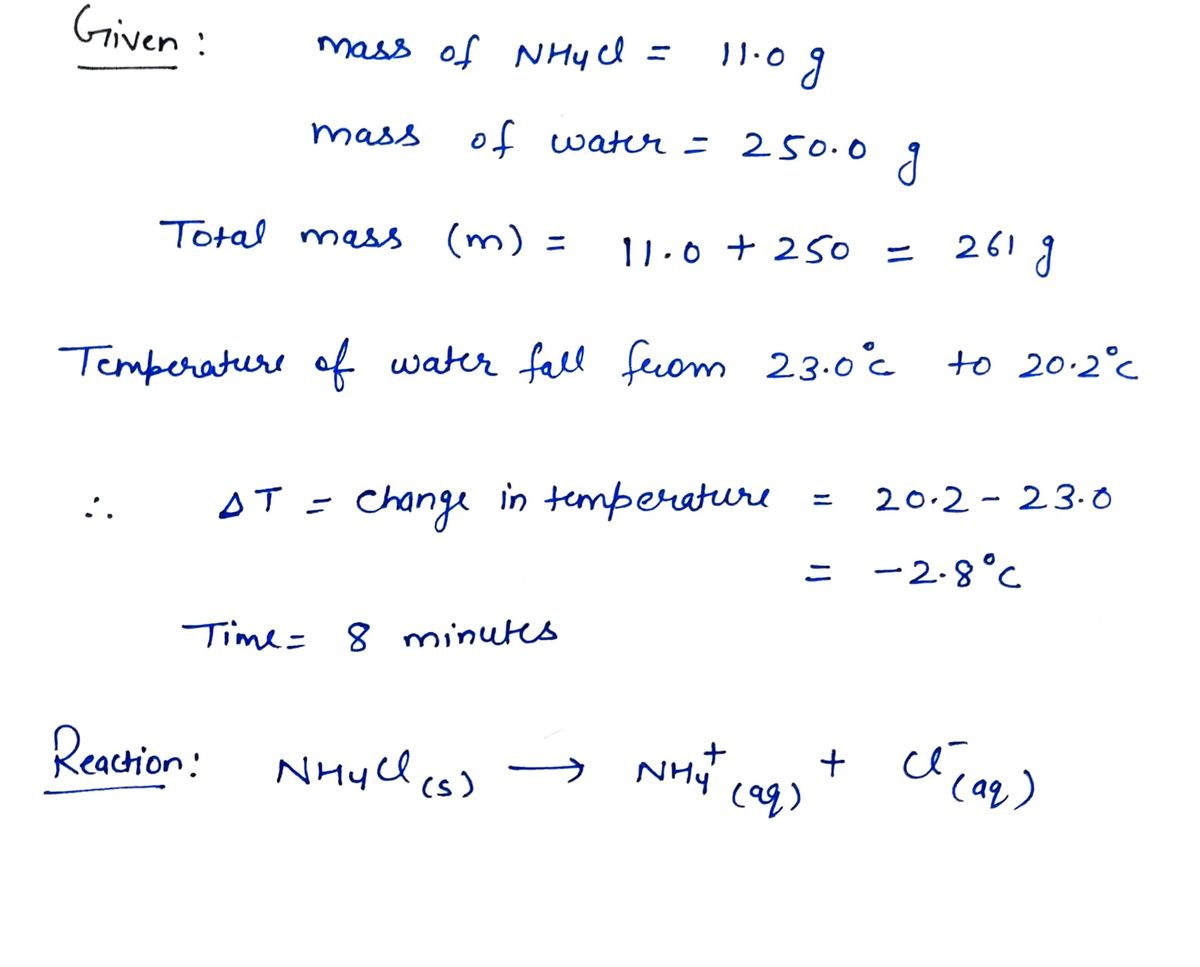A student dissolves 11.0 g of ammonium chloride (NH,C1) in 250. g of water in a well-insulated open cup. She then observes the temperature of the water fall from 23.0 °C to 20.2 °C over the course of 8 minutes. Use this data, and any information you need from the ALEKS Data resource, to answer the questions below about this reaction: NH,C1(s) → NH,(aq) + CI (aq) You can make any reasonable assumptions about the physical properties of the solution. Be sure answers you calculate using measured data are rounded to the correct number of significant digits. Note for advanced students: it's possible the student did not do the experiment carefully, and the values you calculate may not be the same as the known and published values for this reaction. Is this reaction exothermic, endothermic, or neither? If you said the reaction was exothermic or endothermic, calculate the amount of heat that was released or absorbed by the reaction in this case. Calculate the reaction enthalpy AHxn per mole of NH CI. exothermic O endothermic O neither kJ kJ mol S ? FEED do Ar
A student dissolves 11.0 g of ammonium chloride (NH,C1) in 250. g of water in a well-insulated open cup. She then observes the temperature of the water fall from 23.0 °C to 20.2 °C over the course of 8 minutes. Use this data, and any information you need from the ALEKS Data resource, to answer the questions below about this reaction: NH,C1(s) → NH,(aq) + CI (aq) You can make any reasonable assumptions about the physical properties of the solution. Be sure answers you calculate using measured data are rounded to the correct number of significant digits. Note for advanced students: it's possible the student did not do the experiment carefully, and the values you calculate may not be the same as the known and published values for this reaction. Is this reaction exothermic, endothermic, or neither? If you said the reaction was exothermic or endothermic, calculate the amount of heat that was released or absorbed by the reaction in this case. Calculate the reaction enthalpy AHxn per mole of NH CI. exothermic O endothermic O neither kJ kJ mol S ? FEED do Ar
Chemistry
10th Edition
ISBN:9781305957404
Author:Steven S. Zumdahl, Susan A. Zumdahl, Donald J. DeCoste
Publisher:Steven S. Zumdahl, Susan A. Zumdahl, Donald J. DeCoste
Chapter1: Chemical Foundations
Section: Chapter Questions
Problem 1RQ: Define and explain the differences between the following terms. a. law and theory b. theory and...
Related questions
Question
![### Reaction of Ammonium Chloride in Water
A student dissolves 11.0 g of ammonium chloride (\( \text{NH}_4\text{Cl} \)) in 250. g of water in a well-insulated open cup and observes the temperature decrease from 23.0 °C to 20.2 °C over 8 minutes.
#### Reaction Equation:
\[ \text{NH}_4\text{Cl (s)} \rightarrow \text{NH}_4^+ \text{(aq)} + \text{Cl}^- \text{(aq)} \]
#### Questions and Instructions:
1. **Is this reaction exothermic, endothermic, or neither?**
- Options:
- [ ] Exothermic
- [x] Endothermic
- [ ] Neither
2. **Calculate the amount of heat released or absorbed by the reaction in this case.**
- Units: kJ
3. **Calculate the reaction enthalpy \( \Delta H_{\text{rxn}} \) per mole of \( \text{NH}_4\text{Cl} \).**
- Units: \(\text{kJ/mol}\)
#### Additional Information:
- Make reasonable assumptions about the physical properties of the solution.
- Ensure calculations reflect appropriate significant figures.
- Note: The results may vary based on the accuracy of the experimental procedure.
This task involves determining whether the dissolving process is exothermic or endothermic, calculating the heat exchange, and finding the reaction enthalpy per mole, based on observed temperature changes.](/v2/_next/image?url=https%3A%2F%2Fcontent.bartleby.com%2Fqna-images%2Fquestion%2F439811cd-3522-4321-811e-10b69707975d%2F6ccc3864-e9d9-41cf-9fec-0bd1691ac39e%2Fmzenc2l_processed.jpeg&w=3840&q=75)
Transcribed Image Text:### Reaction of Ammonium Chloride in Water
A student dissolves 11.0 g of ammonium chloride (\( \text{NH}_4\text{Cl} \)) in 250. g of water in a well-insulated open cup and observes the temperature decrease from 23.0 °C to 20.2 °C over 8 minutes.
#### Reaction Equation:
\[ \text{NH}_4\text{Cl (s)} \rightarrow \text{NH}_4^+ \text{(aq)} + \text{Cl}^- \text{(aq)} \]
#### Questions and Instructions:
1. **Is this reaction exothermic, endothermic, or neither?**
- Options:
- [ ] Exothermic
- [x] Endothermic
- [ ] Neither
2. **Calculate the amount of heat released or absorbed by the reaction in this case.**
- Units: kJ
3. **Calculate the reaction enthalpy \( \Delta H_{\text{rxn}} \) per mole of \( \text{NH}_4\text{Cl} \).**
- Units: \(\text{kJ/mol}\)
#### Additional Information:
- Make reasonable assumptions about the physical properties of the solution.
- Ensure calculations reflect appropriate significant figures.
- Note: The results may vary based on the accuracy of the experimental procedure.
This task involves determining whether the dissolving process is exothermic or endothermic, calculating the heat exchange, and finding the reaction enthalpy per mole, based on observed temperature changes.
Expert Solution
Step 1: Interpretation of the given information

Step by step
Solved in 3 steps with 3 images

Knowledge Booster
Learn more about
Need a deep-dive on the concept behind this application? Look no further. Learn more about this topic, chemistry and related others by exploring similar questions and additional content below.Recommended textbooks for you

Chemistry
Chemistry
ISBN:
9781305957404
Author:
Steven S. Zumdahl, Susan A. Zumdahl, Donald J. DeCoste
Publisher:
Cengage Learning

Chemistry
Chemistry
ISBN:
9781259911156
Author:
Raymond Chang Dr., Jason Overby Professor
Publisher:
McGraw-Hill Education

Principles of Instrumental Analysis
Chemistry
ISBN:
9781305577213
Author:
Douglas A. Skoog, F. James Holler, Stanley R. Crouch
Publisher:
Cengage Learning

Chemistry
Chemistry
ISBN:
9781305957404
Author:
Steven S. Zumdahl, Susan A. Zumdahl, Donald J. DeCoste
Publisher:
Cengage Learning

Chemistry
Chemistry
ISBN:
9781259911156
Author:
Raymond Chang Dr., Jason Overby Professor
Publisher:
McGraw-Hill Education

Principles of Instrumental Analysis
Chemistry
ISBN:
9781305577213
Author:
Douglas A. Skoog, F. James Holler, Stanley R. Crouch
Publisher:
Cengage Learning

Organic Chemistry
Chemistry
ISBN:
9780078021558
Author:
Janice Gorzynski Smith Dr.
Publisher:
McGraw-Hill Education

Chemistry: Principles and Reactions
Chemistry
ISBN:
9781305079373
Author:
William L. Masterton, Cecile N. Hurley
Publisher:
Cengage Learning

Elementary Principles of Chemical Processes, Bind…
Chemistry
ISBN:
9781118431221
Author:
Richard M. Felder, Ronald W. Rousseau, Lisa G. Bullard
Publisher:
WILEY